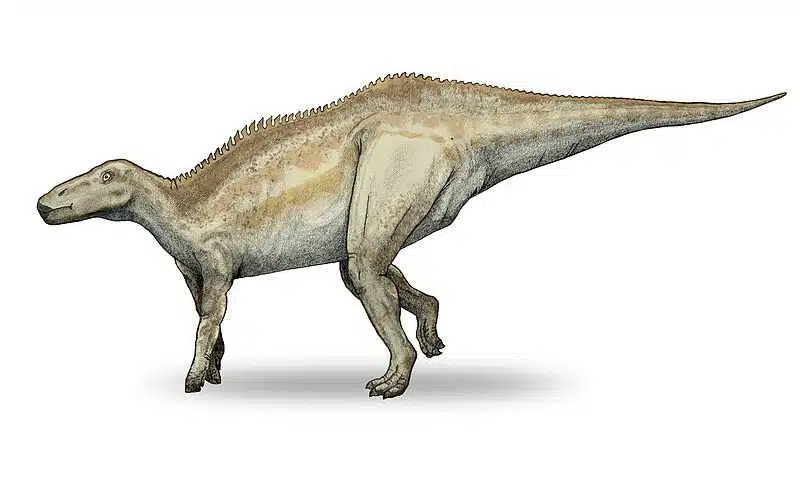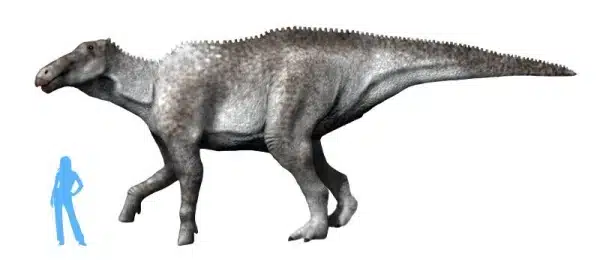Delving into the world of dinosaurs, one cannot help but be captivated by Shantungosaurus, a remarkable creature that roamed the earth during the Late Cretaceous Period. This majestic herbivore, hailing from what is now known as Shandong, China, presents a fascinating chapter in the ancient tapestry of our planet’s history.
Shantungosaurus, a name translating to “Shandong Lizard,” offers a window into a bygone era, a time when these colossal beings were the rulers of their domain. Its discovery not only enriches our understanding of the diverse dinosaur species that once existed but also provides invaluable insights into the ecosystems of the past.
Shantungosaurus Key Facts
| Keyword | Fact |
|---|---|
| Pronunciation | shan-TUN-go-sore-us |
| Meaning of name | Shandong Lizard |
| Group | Ornithopoda |
| Type Species | Shantungosaurus giganteus (syn. Zhuchengosaurus maximus, Huaxiaosaurus aigahtens) |
| Diet | Herbivore |
| When it Lived | 83.6 to 66.0 MYA |
| Period | Late Cretaceous |
| Epoch | Campanian to the top of the Maastrichtian |
| Length | 49.0 to 54.0 feet |
| Height | Approximately 16.0 feet |
| Weight | 14.0 to 18.0 tons |
| Mobility | Moved on four legs |
| First Discovery | 1973 by Xing Xu and other Chinese paleontologists |
| Described by | 1973 by Hu Chengzhi |
| Holotype | GMV 1780-1 |
| Location of first find | Shandong, China |
Shantungosaurus Origins, Taxonomy and Timeline
Shantungosaurus, whose name is a nod to its discovery site in Shandong and the Greek word ‘sauros’ meaning lizard, is a testament to the rich paleontological heritage of China. This Ornithopoda, belonging to the Hadrosaurinae (Ornithopoda: Hadrosauridae), represents a significant link in understanding the diversity of dinosaur species.

Taxonomically, this giant herbivore is classified as Shantungosaurus giganteus, and no other species are described. Its timeline spans the Campanian to Maastrichtian Epochs of the Late Cretaceous Period, approximately 83.6 to 66.0 million years ago, marking it as a witness to the twilight years of the dinosaur era.
Listen to Pronunciation
Discovery & Fossil Evidence
In 1973, the paleontological landscape was enriched with the first description of Shantungosaurus. The initial discovery, spearheaded by Chinese scientist Xing Xu, unveiled around five incomplete skeletons. They provided a substantial foundation for studying this species. In the same year, Hu Chengzhi officially described the dinosaur. These findings, primarily consisting of skull bones, limb bones, and vertebrae, were unearthed in Shandong, China.

Comparative Analysis and Cladistics
Xing Xu and his colleagues have noted striking similarities between Shantungosaurus and Edmontosaurus. The latter is a North American genus that also belongs to the Hadrosaurinae. These similarities extend beyond superficial traits, encompassing many unique characteristics that suggest a close evolutionary relationship. This observation has led to the proposition of an Edmontosaurus–Shantungosaurus clade. It would indicate a significant paleontological connection between North America and Asia. This hypothesis is bolstered by new materials recovered in Shandong. They have further shone a light on the shared traits and evolutionary lineage of these two genera.
Reassessment of Zhuchengosaurus
In 2007, a new genus and species, Zhuchengosaurus maximus, was identified based on specimens found in the same region. Initially, these remains were thought to represent a distinct species due to certain unique features. However, subsequent studies revealed a different story. It became apparent that the supposed distinctions of Zhuchengosaurus were not indicative of a separate species. Instead, they reflected different growth stages of Shantungosaurus. This revelation underscores the complexity of dinosaur classification and the importance of continuous reevaluation in paleontology.
The journey of Shantungosaurus from its initial discovery to the present day is a testament to the evolving nature of scientific understanding. Each fossil, each comparative study, contributes to a more nuanced view of this magnificent dinosaur, painting a picture of a creature that was not only physically imposing but also an integral part of a broader, interconnected ecosystem spanning continents.
- Restored skeletons
- Shantungosaurus giganteus on display at the Tianjin Natural History Museum
Shantungosaurus Size and Description
Shantungosaurus, a behemoth among ornithischians, presents an awe-inspiring figure in the annals of paleontology. Its body, characterized by a long, sturdy frame, was supported by powerful limbs, hinting at a creature built for endurance. The head, crowned with a broad, toothless beak, was complemented by jaws packed with about 1,500 tiny chewing teeth, ideal for its herbivorous diet. Intriguingly, a large hole near its nostrils suggests the presence of a skin flap, possibly used for sound production.
Size and Weight of Type Species

Shantungosaurus giganteus stands as one of the largest known ornithischians. The type skull alone measures an impressive 5.3 feet in length. Mounted skeletons of this species further illustrate its colossal size, with one at the Chinese Academy of Geological Sciences stretching to 48.0 feet and another, initially referred to as Zhuchengosaurus maximus, extending an astonishing 54.0 feet in length.
Weight estimates for the largest individuals of this species reach up to 18.0 tons. However, in a more conservative assessment by Gregory S. Paul in 2016, the size of Shantungosaurus giganteus was moderated to approximately 49.0 feet in length and 18.0 tons) in body mass. Even with these revised figures, this dinosaur remains the largest known hadrosaur, a testament to its remarkable stature in the dinosaur world.
The combination of its immense size, specialized dental structure, and potential for vocalization through a unique nasal feature paints a vivid picture of this Late Cretaceous giant. Shantungosaurus was not just a massive creature; it was a sophisticated animal, well-adapted to its environment and capable of complex behaviors.
Shantungosaurus in Detail
This dinosaur stands out because of several unique features. Its jaw structure, equipped with hundreds of teeth, was perfectly adapted for grinding plant material, a key aspect of its herbivorous diet. The dental batteries were continually replaced, ensuring the dinosaur could efficiently process its food throughout its lifetime.
Another notable aspect is Shantungosaurus’ adaptability. Its robust limbs and bipedal capability suggest a versatile locomotion strategy, allowing it to traverse various terrains in search of food. This adaptability was crucial for survival in the diverse ecosystems of the Late Cretaceous.
The holotype and other specimens have been instrumental in piecing together the life story of Shantungosaurus. Each fossil find adds a layer of understanding, revealing more about this fascinating creature’s anatomy, behavior, and role in its environment.
Contemporary Dinosaurs
Tyrannosaurus, with its towering stature and bone-crushing jaws, posed a formidable threat. While Shantungosaurus was not its primary prey due to its enormous size and strength, younger or weaker members of the Shantungosaurus herd could fall victim to this apex predator. The mere presence of Tyrannosaurus in the vicinity would send ripples of tension through the herd, leading to a cautious and alert atmosphere. Despite its size, Shantungosaurus needed to be wary of these powerful carnivores, especially when protecting its young or navigating through less familiar territories.
Amidst these giants, Sinoceratops added another layer to the ecosystem’s complexity. Its interactions with Shantungosaurus were likely limited to occasional encounters, perhaps at shared water sources or grazing sites. These encounters, while not aggressive, highlighted the diverse range of species that coexisted with Shantungosaurus, each playing a unique role in the rich tapestry of life that thrived in this ancient, dynamic world.
Interesting Points about Shantungosaurus
- Shantungosaurus was one of the largest known Ornithopoda, rivaling some of the largest dinosaurs in size.
- Its jaw contained hundreds of teeth, uniquely adapted for an herbivorous diet, showcasing an efficient feeding mechanism.
- Despite its massive size, this dinosaur was capable of bipedal movement, a remarkable feat given its dimensions.
- The discovery of Shantungosaurus in Shandong, China, significantly contributed to our understanding of dinosaur diversity in Asia.
- The well-preserved fossils of Shantungosaurus provide a detailed glimpse into the anatomy and lifestyle of large herbivorous dinosaurs of the Late Cretaceous.
Shantungosaurus in its Natural Habitat
Imagine Shantungosaurus, a majestic creature, thriving in the lush landscapes of the Late Cretaceous Period. The environment it inhabited was a tapestry of diverse vegetation, supported by a warm and humid climate. This herbivore’s diet was rich in the flora of its era. It would have munched on both ferns and conifers, as well as flowering plants, which were abundant in its habitat.
Shantungosaurus, with its impressive size and likely quadrupedal locomotion, played a significant role in its ecosystem. It likely had a complex relationship with its environment, possibly shaping the vegetation patterns through its feeding habits. As a herbivore, it coexisted with various other species, contributing to the ecological dynamics of its time.
Its social behavior, whether it was a solitary wanderer or a herd animal, remains a subject of intrigue. As a large herbivore it likely had a considerable impact on its surroundings.
Frequently Asked Questions
Shantungosaurus was a herbivore, feeding primarily on plants like ferns, conifers, and flowering plants prevalent during the Late Cretaceous Period.
Estimates suggest that it could reach lengths of up to 50.0 feet, making it one of the largest known Ornithopods.
This dinosaur lived during the Late Cretaceous Period, approximately 83.6 to 66.0 million years ago.
There are a few things that make the Shantungosaurus unique. Most prominent is its enormous size as well as a specialized jaw containing hundreds of teeth for grinding plants.
Sources
The information in this article is based on various sources, drawing on scientific research, fossil evidence, and expert analysis. The aim is to provide a comprehensive and accurate overview of Shantungosaurus.
- https://www.researchgate.net/publication/270912185_Comparative_Osteology_and_Phylogenetic_Relationship_of_Edmontosaurus_and_Shantungosaurus_Dinosauria_Hadrosauridae_from_the_Upper_Cretaceous_of_North_America_and_East_Asia
- https://onlinelibrary.wiley.com/doi/abs/10.1111/j.1755-6724.2011.00378.x
- https://www.tandfonline.com/doi/abs/10.1080/02724634.2015.1054495
Article last fact-checked: Joey Arboleda, 01-16-2024
Featured Image Credit: Debivort, CC BY-SA 3.0 https://creativecommons.org/licenses/by-sa/3.0/, via Wikimedia Commons


